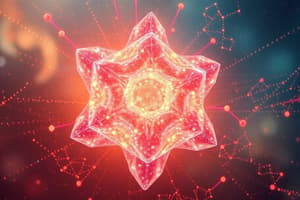Podcast
Questions and Answers
What is the coordination number of the primitive cubic system?
What is the coordination number of the primitive cubic system?
- 4
- 12
- 6 (correct)
- 8
What is the formula for the atomic packing factor of the body-centred cubic system?
What is the formula for the atomic packing factor of the body-centred cubic system?
- 0.74
- 0.68 (correct)
- 0.85
- 0.52
What is the relationship between the cube edge length and the atomic radius in the body-centred cubic system?
What is the relationship between the cube edge length and the atomic radius in the body-centred cubic system?
- a = 2R
- a = R/√2
- a = 2R/√3
- a = 4R/√3 (correct)
What is the origin of the attractive part of the interatomic potential energy?
What is the origin of the attractive part of the interatomic potential energy?
What is the unit of energy commonly used to describe atomic bonding?
What is the unit of energy commonly used to describe atomic bonding?
What is the potential energy of interatomic interaction dependent on?
What is the potential energy of interatomic interaction dependent on?
What is the formula for the energy of an electron moving through a potential difference of one volt?
What is the formula for the energy of an electron moving through a potential difference of one volt?
What is the value of the electron volt in joules?
What is the value of the electron volt in joules?
Flashcards are hidden until you start studying
Study Notes
Crystal Structure
- Atoms, ions, or molecules are spatially arranged in a crystal structure.
- Crystal structure can be 2D or 3D.
2D Crystalline Structure
- Adjacent atoms form a unit cell.
- Example of 2D crystalline structure is shown.
3D Crystalline Structures
Simple (Primitive) Cubic (SC)
- Consists of one lattice point on each corner of the cube.
- Each atom at a lattice point is shared equally between eight adjacent cubes.
- Unit cell contains one atom (1/8 × 8).
- Coordination number (nearest neighbor) is 6.
Body-Centred Cubic (BCC)
- Has one lattice point in the centre of the unit cell in addition to the eight corner points.
- Net total of 2 lattice points per unit cell (1/8 × 8 + 1).
- Examples: Cr, α-Fe, Mo.
- Cube edge length, a = 4R/√3, R = a√3/4.
- Atomic packing factor (APF) = 0.68.
Face-Centred Cubic (FCC)
- Examples: Cu, Al, Ag, Au.
Interatomic Interaction
- Repulsion between atoms is related to the Pauli principle.
- Energy of the system increases abruptly when electronic clouds surrounding atoms start to overlap.
- Attractive part of the potential energy curve dominates at large distances.
Potential Energy of Interatomic Interaction
- Can be calculated from the potential energy curve.
- Depends only on the distance between the two atoms, U(r12).
Energy Units
- Electron volt (eV) is a convenient unit for atomic bonding.
- Defined as the energy lost or gained by an electron when taken through a potential difference of one volt.
- 1 eV = 1.6 × 10^-19 J.
Studying That Suits You
Use AI to generate personalized quizzes and flashcards to suit your learning preferences.




